POSTAL UPDATES
insights
A personalized reference manual can be a beneficial problem-solver
By Janet Klug
It may not take long for a new stamp collector to become discouraged both with stamp-collecting terminology (often a language all its own) and stamps that are difficult to identify.
Let’s face it: It isn’t always easy for longtime collectors, either.
I found myself once again checking stamp-identifier books that, for the hundredth time, remind me that a stamp with the wording “N D Hrvatska” goes in the album on pages for Yugoslavia or Croatia.
The stamps that are mounted on the Yugoslavia pages are overprinted “HRVATSKA” on Hungarian stamps or stamps inscribed “DRZAVNA POSTA HRVATSKA.”
Connect with Linn's Stamp News:
Like us on Facebook
Follow us on Twitter
Keep up with us on Instagram
The stamps mounted on Croatia album pages are overprinted “NEZAVISNA DRZAVA HRVATSKA” on Yugoslavia stamps.
Later, in 1941, Croatia began issuing its own stamps inscribed “NEZAVISNA DRZAVA HRVATSKA,” and in 1991 the stamps were inscribed “Republika Hrvatska.” And, unfortunately, these are only some of many hundreds of tricky stamps.
Some stamps show up in mixtures and have no obvious characteristics that will help you find the right spot for them in your stamp albums.
For example, you have a stamp that depicts a man wearing a crown and looking to the right. The stamp has inscriptions in an odd-looking alphabet that resembles neither Asian nor Cyrillic letters. Where can this stamp be from?
Fortunately, this particular stamp is shown in the “Illustrated Identifier” section in the back of the Scott Standard Postage Stamp Catalogue. Ah ha! The stamp is from Ethiopia.
There are many good reference books for stamp identification, but it takes time and patience to use them to determine your stamps’ origins. One option is to assemble your own reference book, in which case you can flip to the section on tricky stamps and find a match instantly, saving a lot of time.
After too much time spent repeatedly looking up the same inscriptions in stamp identifiers, I made a page (see the first illustration here) for my reference book that makes quick work of indicating where an “N D Hrvatska” stamp belongs in my albums.
I also mounted the stamp with the crowned man and the unusual alphabet, and labeled it as coming from Ethiopia.
The next time one of these stamps or a very similar one shows up in my latest purchases, it will take only a few seconds to consult my reference book and find the identifications.
Are there stamp-hobby terms that you find confusing?
Se-tenant and tete-beche, for example, confuse many collectors.
A page in your reference book under “terminology” (see second illustration here) provides examples of the difference between the terms. Essentially, se-tenant refers to two or more joined-together stamps of different designs, colors, denominations or types. Tete-beche is French for “head to tail” and indicates two or more unseparated stamps that are upside down in relation to one another.
Sometimes we just get a mental block about something that we know perfectly well at other times. Once in a while, who knows why, I get the perforations of coil stamps confused.
Coil stamps come in rolls and usually have two opposite edges that are straight. The other two opposite edges are perforated. The perforations can be top and bottom, or left and right. The terminology for separation of stamps on coil rolls refers to vertical or horizontal. So, for a vertical coil, does that mean the straight edges are vertical or the perforations are vertical?
I fixed that problem once and for all by making a page for my reference book, as shown in the final illustration. I started with a little drawing and ended with enlarged scans of both vertical and horizontal perfs. I won’t get them confused again.
Having shown you a few samples of my stamp-collecting stumbling blocks and their solutions, you may have recalled some of your own problems and want to create a personalized reference book. Here is how.
Acquire a ring binder, some notebook paper, and a package of page dividers. Make a list of subjects that you find difficult; these might include terminology, hard-to-identify stamps, stamps that look alike but are not the same catalog number, odd abbreviations that pepper auction catalogs and dealer listings, and so on. You will find more subjects to add to your list as you work on your collection.
Start making a few pages, using images as much as possible. Too much writing is likely to make the project more tedious, and you will be less inclined to continue adding useful content.
You can make quick sketches if you have the ability to draw, or use some of your surplus or damaged stamps as examples. You also might retrieve pertinent images from the Internet and add them to your personal reference book.
Give each section of your reference book a name, with the section name on a page divider, so you can get to the right place quickly each time you use the book.
This is truly a fun project, and once you’re assembling your reference manual you are likely to find that the process actually helps to implant the information more solidly into your memory.
This is an easy do-it-yourself project that costs very little money, and the time required is usefully spent. What have you got to lose?
MORE RELATED ARTICLES
Headlines
-
US Stamps
Oct 7, 2024, 3 PMMcMurtrie dismissed as APS education director following Sept. 21 arrest
-
US Stamps
Oct 7, 2024, 12 PMVasiliauskas named president of Mystic Stamp Co.
-
US Stamps
Oct 6, 2024, 5 PMApgar souvenir card available
-
US Stamps
Oct 6, 2024, 4 PMFirst Continental Congress and U.N. stamps receive Scott catalog numbers








